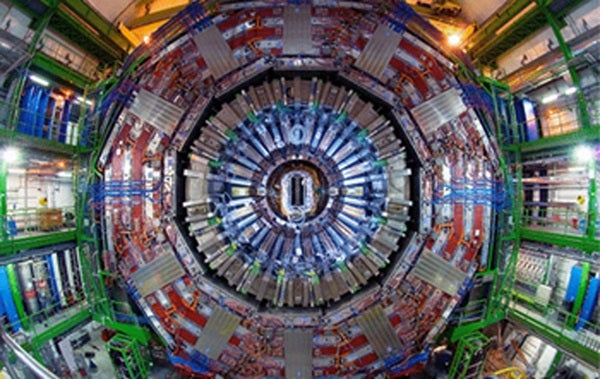According to the standard model, the remarkably successful theory of how all the fundamental particles interact, the Higgs boson is responsible for endowing every other particle with mass. And as the last remaining particle predicted by the standard model yet to be detected, its discovery is one of the chief goals of the LHC, the most powerful particle accelerator on Earth, and perhaps the most complex scientific endeavor ever attempted.
Sitting underground near Geneva, Switzerland, the LHC accelerates protons around a ring almost 5 miles (8 kilometers) wide to nearly the speed of light, producing two proton beams that careen toward each other. Most of the protons just keep on going past each other, but a small fraction of them collide, creating other particles in the process. But these particles are fleeting, decaying into lighter particles before they can be detected. The challenge for physicists is to pick out hints of new, exotic physics from the flurry of newly minted particles. By sifting through the data, they hope to tease out signs that some of these particles are Higgs bosons.
The LHC is equipped with several detectors, but the ones that are the largest and are going after the Higgs are called A Toroidal LHC ApparatuS (ATLAS) and the Compact Muon Solenoid (CMS); Caltech plays a prominent role in the latter. Both experiments recently reported what physicists are calling “excess events.” That is, the LHC appears to have created slightly more events than would be expected if the Higgs does not exist. The bump occurred in the region between 130 and 150 gigaelectron volts (GeV — a unit of energy that is also a unit of mass), which is the expected mass range of the Higgs. But the data is not yet statistically significant enough to be called a definite signal, let alone a discovery of the Higgs particle, said Harvey Newman from Caltech.
There are two possible explanations for these results, he said. The bump in the data could just be background events due to some unknown source or it could be the first signs of the Higgs. “One could speculate that it’s an unusual statistical fluctuation,” Newman said. “But I don’t think so.”
The LHC is now operating with 7 teraelectron volts (TeV, a thousand times higher than a GeV) of energy at the center of mass between the two proton beams, and may increase to 8 TeV next year (the maximum energy is 14 TeV, which will be reached by 2014).
Physicists will continue to ramp up the LHC, boosting it to higher energies and increasing the number of collisions to improve the chances of producing Higgs bosons. With several times more particle interactions, the physicists are continuing to close in on the Higgs, as well as other new particles and interactions. There’s a chance that by the end of next year, they may determine whether the Higgs exists.
According to the standard model, the remarkably successful theory of how all the fundamental particles interact, the Higgs boson is responsible for endowing every other particle with mass. And as the last remaining particle predicted by the standard model yet to be detected, its discovery is one of the chief goals of the LHC, the most powerful particle accelerator on Earth, and perhaps the most complex scientific endeavor ever attempted.
Sitting underground near Geneva, Switzerland, the LHC accelerates protons around a ring almost 5 miles (8 kilometers) wide to nearly the speed of light, producing two proton beams that careen toward each other. Most of the protons just keep on going past each other, but a small fraction of them collide, creating other particles in the process. But these particles are fleeting, decaying into lighter particles before they can be detected. The challenge for physicists is to pick out hints of new, exotic physics from the flurry of newly minted particles. By sifting through the data, they hope to tease out signs that some of these particles are Higgs bosons.
The LHC is equipped with several detectors, but the ones that are the largest and are going after the Higgs are called A Toroidal LHC ApparatuS (ATLAS) and the Compact Muon Solenoid (CMS); Caltech plays a prominent role in the latter. Both experiments recently reported what physicists are calling “excess events.” That is, the LHC appears to have created slightly more events than would be expected if the Higgs does not exist. The bump occurred in the region between 130 and 150 gigaelectron volts (GeV — a unit of energy that is also a unit of mass), which is the expected mass range of the Higgs. But the data is not yet statistically significant enough to be called a definite signal, let alone a discovery of the Higgs particle, said Harvey Newman from Caltech.
There are two possible explanations for these results, he said. The bump in the data could just be background events due to some unknown source or it could be the first signs of the Higgs. “One could speculate that it’s an unusual statistical fluctuation,” Newman said. “But I don’t think so.”
The LHC is now operating with 7 teraelectron volts (TeV, a thousand times higher than a GeV) of energy at the center of mass between the two proton beams, and may increase to 8 TeV next year (the maximum energy is 14 TeV, which will be reached by 2014).
Physicists will continue to ramp up the LHC, boosting it to higher energies and increasing the number of collisions to improve the chances of producing Higgs bosons. With several times more particle interactions, the physicists are continuing to close in on the Higgs, as well as other new particles and interactions. There’s a chance that by the end of next year, they may determine whether the Higgs exists.










